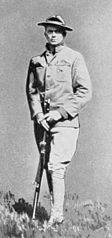Frederick Hird
| |||
 | |||
| Pełne imię i nazwisko | Frederick Sylvester Hird | ||
|---|---|---|---|
| Data i miejsce urodzenia | 6 grudnia 1879 New Diggings | ||
| Data i miejsce śmierci | 27 września 1952 Des Moines | ||
| Dorobek medalowy | |||
Frederick Sylvester „Fred” Hird (ur. 6 grudnia 1879 w New Diggings, zm. 27 września 1952 w Des Moines) – amerykański strzelec sportowy, medalista olimpijski.
W młodości Hird był czołowym lekkoatletą, półprofesjonalnym baseballistą i bokserem. W 1900 roku dołączył do Gwardii stanu Iowa, by osiągnąć ostatecznie stopień leutnanta w 1943 roku. Był weteranem amerykańsko-meksykańskiego konfliktu granicznego w 1914 roku oraz I wojny światowej.
Hird wziął udział w igrzyskach olimpijskich dwukrotnie. Podczas V Letnich Igrzysk Olimpijskich w Sztokholmie w 1912 roku wziął udział w siedmiu konkurencjach strzeleckich. W strzelaniu z karabinu dowolnego w trzech pozycjach z 300 metrów zdobył trzydzieste ósme miejsce z wynikiem 875 punktów. W konkursie karabinu wojskowego w trzech pozycjach z 300 metrów zdobył 84 punktów i 28. miejsce. W strzelaniu z karabinu wojskowego z 600 metrów w dowolnej pozycji zdobył 81 punktów i szóste miejsce. Domeną Hirda okazało się strzelanie z karabinu małokalibrowego. W strzelaniu z 25 metrów zajął ósme miejsce zdobywając 221 punktów. W konkurencji drużynowej z tej samej odległości zdobył brązowy medal. W strzelaniu z odległości dwa razy dłuższej w konkurencji indywidualnej zdobył złoto wynikiem 194 punktów, ustanawiając nowy rekord olimpijski, zaś w konkurencji drużynowej zdobył swój drugi złoty medal. Osiem lat później na igrzyskach w Antwerpii wystartował w jednej konkurencji, strzelaniu z karabinu wojskowego z 300 metrów w pozycji stojącej, gdzie zdobył 55 punktów.
Bibliografia
- Frederick Hird na Sports-reference.com (ang.). Sports-reference.com. [dostęp 2014-01-19]. [zarchiwizowane z tego adresu (2014-10-23)].
Media użyte na tej stronie
Pictograms of Olympic sports - Shooting. This is unofficial sample picture. Images of official Olympic pictograms for 1948 Summer Olympics and all Summer Olympics since 1964 can be found in corresponding Official Reports.
The flag of Navassa Island is simply the United States flag. It does not have a "local" flag or "unofficial" flag; it is an uninhabited island. The version with a profile view was based on Flags of the World and as a fictional design has no status warranting a place on any Wiki. It was made up by a random person with no connection to the island, it has never flown on the island, and it has never received any sort of recognition or validation by any authority. The person quoted on that page has no authority to bestow a flag, "unofficial" or otherwise, on the island.
The Canadian Red Ensign used between 1921 and 1957.
This image has compared for accuracy (mainly colors) using an image from World Statesmen. The only change is making the maple leaves green from red. This image has compared for accuracy (mainly colors) using an image from World Statesmen. The most recent version of this image has changed the harp into one with a female figure; see [http://flagspot.net/flags/ca-1921.html FOTW
State Flag of Venezuela 1930-2006, New flag was introduced 13 March 2006.
Flag of New Zealand. Specification: http://www.mch.govt.nz/nzflag/description.html , quoting New Zealand Gazette, 27 June 1902.
Flag of Romania, (21 August 1965 - 22 December 1989/officialy 27 December 1989).
Construction sheet of the Flag of Romania as depicted in Decree nr. 972 from 5 November 1968.
- l = 2/3 × L
- C = 1/3 × L
- S = 2/5 × l
Flag of Romania, (21 August 1965 - 22 December 1989/officialy 27 December 1989).
Construction sheet of the Flag of Romania as depicted in Decree nr. 972 from 5 November 1968.
- l = 2/3 × L
- C = 1/3 × L
- S = 2/5 × l
Autor: Scroch, Licencja: CC BY-SA 3.0
Flag of Bulgaria (1971-1990). Flag of Bulgaria with Bulgarian coat from 1971.
Olympic Movement flag
Proportions 2:3, created 1913, adopted 1914, first used 1920.
- Colors as per http://fairspielen.de/wp-content/uploads/2015/09/Annexe-3-Olympism_and_the_Olympic_Symbol_-_Principles_and_Usages_Guide-1.pdf
- blue: PMS 3005C
- yellow: PMS 137C
- black: PMS 426C
- green: PMS 355C
- red: PMS 192C
- Dimensions of the rings taken from http://fairspielen.de/wp-content/uploads/2015/09/Annexe-3-Olympism_and_the_Olympic_Symbol_-_Principles_and_Usages_Guide-1.pdf
Флаг Российской СФСР, 1937-1954 гг.
Frederick Hird at the 1912 Summer Olympics
Flag of the unified Team of Germany for the Olympic Games, 1960–1968.



































